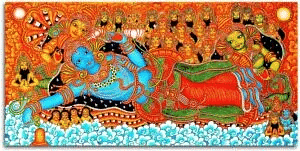Humanities/Arts Exam > Humanities/Arts Notes > Fine Art for Class 11 > Important Points: Later Mural Traditions
Important Points: Later Mural Traditions | Fine Art for Class 11 - Humanities/Arts PDF Download
1. Badami (Karnataka):
- Capital of the early Chalukyan dynasty (543-598 CE).
- Chalukya king Mangalesha patronized the Badami caves.
- Paintings depict palace scenes including Kirtivarman I with his wife, and figures of Indra and his retinue.
- Stylistically linked to the Ajanta tradition with sinuous lines, fluid forms, and compact composition.

2. Murals under Pallava, Pandya, and Chola Kings:
- Pallavas: Temples at Panamalai, Mandagapattu, Kanchipuram; Mahendravarman I known for titles showing interest in art.
- Pandyas: Tirumalaipuram caves and Jaina caves at Sittanvasal with paintings on ceilings, verandas, and brackets.
- Cholas: Temples at Brihadeswara (Thanjavur), Gangaikonda Cholapuram, Darasuram; paintings showing Lord Shiva, dancing figures, and portraits.
3. Vijayanagara Murals:
- Early phase represented by paintings at Tiruparakunram.
- Hampi: Virupaksha temple with paintings narrating dynastic history, Ramayana, and Mahabharata.
- Lepakshi (Andhra Pradesh): Shiva temple with examples of Vijayanagara paintings.
- Nayaka Period: Extension of Vijayanagara style with regional modifications, scenes from Mahabharata, Ramayana, and Krishna-leela.
4. Kerala Murals:
- Sixteenth to eighteenth century.
- Influenced by Kathakali and kalam ezhuthu traditions.
- Themes from Hindu mythology popular in Kerala.
- Sites include Dutch palace (Kochi), Krishnapuram palace (Kayamkulam), Padmanabhapuram palace, and temples like Pundareekapuram Krishna temple, Panayanarkavu, Thirukodithanam, Triprayar Sri Rama temple, and Trissur Vadakkunathan temple.
5. Contemporary Traditions:
- Mural painting on interior and exterior walls in villages and havelis.
- Examples: Pithoro in Rajasthan and Gujarat, Mithila painting in Bihar, Warli paintings in Maharashtra, and various forms in Odisha, Bengal, Madhya Pradesh, and Chhattisgarh.
The document Important Points: Later Mural Traditions | Fine Art for Class 11 - Humanities/Arts is a part of the Humanities/Arts Course Fine Art for Class 11.
All you need of Humanities/Arts at this link: Humanities/Arts
|
10 videos|24 docs|16 tests
|
FAQs on Important Points: Later Mural Traditions - Fine Art for Class 11 - Humanities/Arts
| 1. What are some examples of later mural traditions in the humanities/arts? |  |
Ans. Some examples of later mural traditions in the humanities/arts include the frescoes of the Italian Renaissance, the murals of the Mexican Muralism movement, and contemporary street art found in urban areas around the world.
| 2. How do later mural traditions contribute to the cultural heritage of a society? |  |
Ans. Later mural traditions contribute to the cultural heritage of a society by serving as visual representations of historical events, cultural values, and societal issues. They also provide a sense of identity and pride to the community in which they are located.
| 3. What materials are commonly used in creating murals in the humanities/arts? |  |
Ans. Common materials used in creating murals in the humanities/arts include paint, brushes, scaffolding, and various types of surfaces such as walls, ceilings, and panels. In some cases, artists may also use digital tools to create murals.
| 4. How do later mural traditions in the humanities/arts differ from earlier mural traditions? |  |
Ans. Later mural traditions in the humanities/arts often incorporate more contemporary themes, styles, and techniques compared to earlier mural traditions. They may also reflect the social and political issues of the time in which they were created.
| 5. What is the significance of preserving and conserving later mural traditions in the humanities/arts? |  |
Ans. Preserving and conserving later mural traditions in the humanities/arts is important for maintaining cultural heritage, promoting artistic expression, and educating future generations about the history and values of a society. It also helps to ensure that these valuable works of art are not lost to decay or destruction.
Related Searches
















